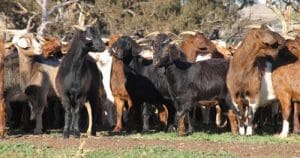
Rangeland goats.
AUSTRALIA’S goat meat industry will make a concerted effort to forecast its annual production for the first time this year, as part of research to generate accurate supply data and predictions.
The nation’s beef, sheep meat and wool industries have highly developed models, data sources and producer surveys enabling them to make annual supply projections, but this has not been attempted for goat meat.
However, NSW Department of Primary Industries development officer Trudie Atkinson heads up a team undertaking the goat industry data collation and tracking project up to February 2020.
Goat Industry Council of Australia president Rick Gates said the goat industry did not have all the information it needed to make production forecasts, as in the sheep, wool and cattle sectors.
“We know where we have been, we just want to have a bit of an idea of where we are going in the next 12 months.”
He said having goat meat industry projections would be “better than just flying blind”.
Goat population and offtake models needed
Ms Atkinson said the project has three components; improving access to industry data, population modelling and supply forecasting.
“There is pretty good data about the amount of goat meat being supplied to the different export markets, but ehre is a lack of information about where the goats originate from and the production trends.
“If you look at current industry data it incorrectly shows that only a small proportion of goats are produced in New South Wales, but that is a function of them being processed in different states,” she said.
“This would include analysis of how many goats flow into processors through depots and how many go direct to processors.”
Secondly, Ms Atkinson said there were “question marks” around the impact of the current rangeland goat offtake on the remaining population.
“What impact is the current harvest rate having on the unmanaged population?”
The third component of the project was about using population and offtake models in a similar process to which the sheep and cattle industries use — with producer surveys and forecast committees — to build industry’s capacities to do that forecasting.”
First goat meat forecast attempted this year
Ms Atkinson said the project team was currently working on the supply models and then the industry will be asked to forecast goat meat supply for 2017-2018 financial year.
“We have a three-year project where we can build and improve the models, and improve the industry forecasting skills.
“We don’t know how we will go for the first time, but we will certainly be giving it a go around July-August this year.”
Industry issues that will be looked at in the project include a comparison of the managed vs unmanaged goat population.
“We’re using existing data to try to improve our understanding of the (goat meat) supply chain.”
Accurate data will help assess goat meat trends
Ms Atkinson said accurate goat meat supply data will send a clearer message about where the industry is heading and what it needs.
“For example, if we can see that there is going to be a shortfall because of the wild harvest population potentially declining, then we can send a clear message that the industry has got to start increasing production from managed goat herds.
“Certainly if we had better supply projections, it would allow us to make better decisions about what processing capacity the industry needs and how fast that needed to develop,” she said.
“It sends a confident message to people who are developing markets that supply is going to be there to expand those markets.
“At the moment there is just a lot of uncertainty about that.”
Goat slaughter up as indicators surge
MLA’s National Livestock Reporting Service last week said the number of goats slaughtered in eastern states last week was 52,970, up 13 percent on the corresponding week last year, with hot and dry weather across the eastern states over the last month assisting goat harvesting operations.
The NLRS said the eastern states goat over-the-hook indicators moved into new territory last week, lifting 11-15c/kg cwt from last fortnight, with all categories surpassing 650c/kg cwt. Goats (10-16kg cwt) averaged 655c/kg cwt last week – 139 cents higher than the same time last year, and 464 cents above where the indicator tracked five years ago. The top goat meat OTH quote for all categories last week was 730c/kg cwt.



HAVE YOUR SAY